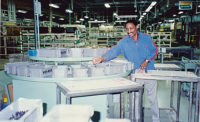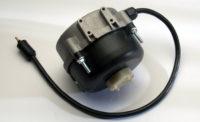Output estimates, which are typically established by a department foreman.
Historical output, which is based on past accomplishment.
Industrial engineering standards, which are developed by trained and experienced engineers.
The primary advantage of estimates and historical output is that they don’t cost anything to develop. Unfortunately, they are rarely accurate. They are almost always 15 percent below an industrial engineering standard.
Whether you’re planning a productivity improvement project or running cost estimates, if you really want to know how your assembly line is performing, you need to get out on the shop floor and do some time measurement studies. The following steps will provide valuable information that can be used to improve any repeatable assembly operation.
First, define your objective. What is your primary goal? Is it cost reduction, labor reporting, operator assessment, pricing or line balancing? Determining your objective will help you develop a time frame to accomplish your goal.
Next comes work method optimization. Start by writing out the steps or procedures for the current method of assembly, and then consider alternatives. Before you time anything, make sure the process is safe and ergonomic. Are the parts and tools clearly visible and within easy reach? If there are no glaring ergonomic issues, do some quick cycle time measurements of the current and alternative assembly methods to ascertain which method takes the least overall time. This will give you an idea of where to concentrate your efforts before developing a detailed time study.
Now you can do detailed work measurements for labor cost estimates or industrial engineering standards. For each operation, you’ll want to:
Scrutinize the work elements for optimum methodology.
Plot time values for each work element. Through direct observation, take a minimum of 10 cycle time measurements of each work element for each assembly operation.
Average the cycle times, or select a representative time that best suits your operator rating. Rate the performance level of each work element for the operator observed.
Total the average time values for each operation.
Factor in allowances for unavoidable delays and fatigue.
Calculate operational standards. Convert the factored total from your standard to a rate that makes sense, such as pieces per hour, pieces per day or hours per hundred assemblies.
Once you have an industrial engineering standard for how long a process should take, compare it against the current operation. Have your accounting and payroll departments “run the numbers” for the current operation vs. your ideal. Make sure your cost objectives will be achieved before implementing the new standard.
That last step is important. Only implement the new standard if it meets your cost objectives. Years ago, I wanted to implement industrial engineering standards at a union shop. My efforts drew the suspicion of union stewards, and I was forced to quote the new standards immediately after the time studies were completed and before the time-study technician had even left the floor. Don’t give in to such pressure. Do it right and test the results before implementing the standard.
With the standard in place, it’s up to you to maintain it. Bear in mind that slight changes in the assembly process can increase or decrease the time standard you developed. Over the years, those slight changes can add up to a major change, and you’ll have to repeat the entire time-study process. Thus, it’s to your advantage to keep your department’s industrial engineering standards current.
Low-Volume Shops
Industrial engineering standards can even be implemented in low-volume operations.
Consider an assembly plant that makes large machines in low volumes. A typical machine might require 2,000 hours to assemble over a three-month time frame and be routed through multiple buildings for fabrication, paint, subassembly, final assembly and packaging.
Even if no two final assemblies are alike, each machine will have common blocks of work, such as the installation of a particular gauge or door.
Although there are historical records of the hours needed to produce the fabricated parts and subassemblies, there is no accurate measurement of operator efficiency or hours per finished unit, since there are no industrial engineering standards and no repeat orders for a specific machine.
Nevertheless, management wants improvement on labor costs. So where to start? Direct labor controls depend on accurate standards and methods. In this scenario, your initial concentration should be on developing accurate standards for fabrication and subassembly. Remember: Using historical data to predict the cost, labor content and scheduling of a fabrication or subassembly will typically be off by at least 15 percent, so you can expect at least that much in labor savings.
Begin by developing standards for common fabricated parts. Follow the procedure for repeatable work tasks.
Time quotes for unique fabricated parts can be estimated based on the standards for common parts. To verify these estimates, do a time study of the unique fabricated parts. In this case, you will only see one assembly, so you’ll need to describe the operation you are observing with your stop watch running continuously.
Document the beginning of each operation with a new start time, and later subtract the start times from each other to calculate a net time for the entire operation. Level each operation as it is concluded, then follow the methodology for a repeatable work task. Compare this time study of a nonrepeatable work task with its respective estimate to substantiate the latter. Recalculate the estimate if it’s off by more than 10 percent.
Industrial Incentives
Armed with industrial engineering standards for operators, plant management can institute a variety of incentives to boost performance.
For example, assemblers can be rewarded based on measured day work. Workers are paid a weekly bonus for achieving 100 percent of the standard.
An alternative is the “hours earned” method. When a shift produces an assembly, it “earns” the standard hours allocated for that assembly’s process. At the end of the month, the total hours earned are compared to the total hours spent. A shift that produces assemblies more efficiently than the standard creates a favorable variance. One that spends more hours than the standard produces an unfavorable variance.
Let’s say a shift needs to produce 100 assemblies, and you’ve determined that each assembly should take one hour to produce. When the shift completes these assemblies, it will have earned 100 hours. If it actually took 110 hours to produce the assemblies, that represents an unfavorable variance of 10 hours. On the other hand, if the shift produces those assemblies in 90 hours, that’s a favorable variance of 10 hours.
That variance is then translated into financial terms. If the labor rate is $10 per hour, and the plant spends $1,000 (100 actual hours x $10) to earn $1,000 (100 standard hours x $10), then the variance is zero ($1,000 actual – $1,000 earned). Assemblers are rewarded if the plant spends $1,000 for labor and earns $1,100 in standard dollars. The shift can split all or some of that $100 difference as a bonus. However, if the plant spends $1,000 and only earns $800, no one gets a bonus.
Another option is gain sharing. In this case, bonus pay is tied to output per shift, as well as weekly increases in uptime, yield, quality and attendance. Other indices, such as delivery time and scrap, can be measured on a year-to-date basis, but paid weekly. This system rewards those who are directly involved in product assembly, as well as those with indirect roles, such as fork truck drivers, material handlers and machine setup personnel.
Editor’s note: Joseph D. Gray has more than 30 years experience in industrial engineering, automation, material handling and lean manufacturing. An expert in the planning, design, balancing and installation of paced systems, Gray has engineered more than 100 synchronized production lines and 1,000 finished products. Before launching his consulting business, Gray served as a factory automation manager with Perkin-Elmer, foreman with Honeywell, and productivity improvement manager for Johnson & Johnson. This article is an excerpt from his forthcoming book, Classic Productivity Systems, published by iUniverse.







